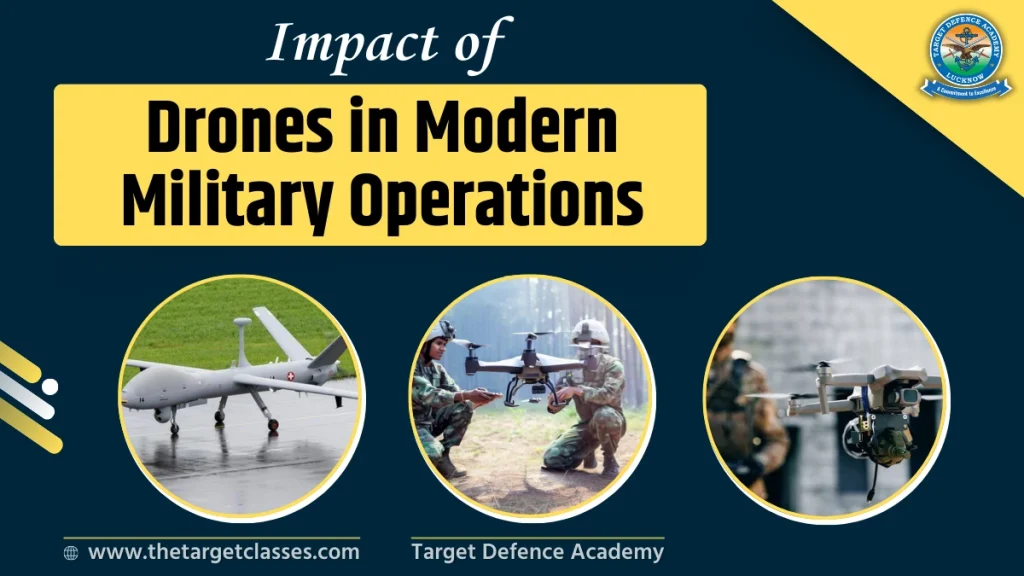Drones, or unmanned air vehicles (UAVs), have moved from experimental things to become indispensable tools in modern military operations. Over the past two decades, these air systems have completely changed how wars are fought, intelligence is gathered, and the missions are performed. From surgical strike to high height monitoring, the drone has given a strategic edge without exposing any human life to direct danger to human life. This article examines the strategic and operational effects of drones in modern military operations, analysing the benefits, boundaries and future abilities.

1. The Rise of Military Drones
The idea of unmanned air systems is not new – it dates previous to the First World War 1 when the concept of remote controlled aircraft was first tested. However, the 21st century has seen a unique leap in UAV technology. Countries such as the United States, Israel, China and India have developed real-time monitoring, accurate attacks and even skilled advanced drones for electronic war. Notable developments include:
- MQ-9 Reaper – Used extensively by the US for long-range precision missions.
- Heron UAV – Was adopted by India for reconnaissance and goal acquisition.
- Bayraktar TB2 – Was made by Turkey, proved to be crucial in recent conflicts.
This development has changed military principles, making the drone struggle an important part of the strategy.
2. Strategic Advantages of Drones in Warfare
Drones provide several key benefits that traditional aircraft cannot match:
a. Risk-Free Operations
Since drones are unmanned, they eliminate the risk of pilot injuries during assignments in hostile environments.
b. Cost-Effectiveness
The operating drone is much cheaper than maintaining fighter jets or bombers. Their maintenance and operating costs are low, making them economically viable.
c. Real-Time Intelligence
Equipped with high-quality cameras, thermal sensors and radar structures, drone command facilities can collect battlefield information. This provides features such as quick decision-making and correct targeting.
d. Precision Strikes
Modern UAVs can launch missiles and smart bombs to attack high-value targets with minimal security damage.
3. Types of Military Drones and Their Roles
Military drones come in variety of forms, each serving a unique purpose. The various types of drones are
- Reconnaissance Drones
- Combat Drones
- Logistics Drones
- Electronic Warfare Drones
Each kind contributes to a multi-layered war method, improving each protection and offence.
4. Drones in Modern Battlefields
Recent conflicts which include the Russia-Ukraine warfare, the Nagorno-Karabakh war, and counterterrorism operations inside the Middle East have showcased the deadly efficiency of drones. UAVs have been used for:
- Tracking enemy troop movements
- Conducting targeted assassinations of high-value targets
- Delivering ammunition and medical supplies
- Neutralising enemy air defences
These applications have reduced mission times, human losses and increased operational accuracy.
Cyber Warfare: India’s New Defence Frontier
Drones Used by Indian Armed Forces | Complete List & Details
NDA Foundation Course After 10th | Best NDA Coaching in India after 10th
Download the Mobile App of Target Defence Academy
5. Ethical and Security Concerns
While drones provide unmatched efficiency, their use also raises important problems:
- The number of social injuries – Mistargeting can cause unintended loss of innocent life.
- Autonomous war risk-operated drones can work without human monitoring.
- Spread-not-the-state actor can increase the dangers of terrorism they gain access to fighter drones.
Therefore, the global defence communities argue about the rules for involvement and international drone war laws.
6. The Future of Drones in Military Operations
The next future generation of drones will likely be:
- AI-based autonomous decision-making
- Stealth technology for undetectable operations
- Swarm drone tactics for overwhelming enemy defences
- Integration with space-based monitoring systems
During the coming decade, the drones could completely change some staffed missions, making them the backbone of military campaigns.
Conclusion
The effect of drones on the operation of the military is undisputed-they have redefined modern war by improving accuracy, reducing the dangers and enabling real-time intelligence. However, when technology steps up, nations must balance strategic blessings with moral duty to ensure that drones remain a pressure for strategic balance in preference for uncontrolled destruction.
FAQs about Drones in Modern Military Operations
Ans. The US, Israel, China, and Turkey are among the global leaders in advanced UAV development.
Ans. Yes, autonomous drones can act without direct human control, but most terrorists still require human surveillance for war decisions.
Ans. Not quite, but they are complementary and in some cases replace some assignments that are very risky for manned aircraft.
Ans. They are used for monitoring, logistics support and ceasefire lines without risking human personnel.
Ans. Their vulnerability to electronic warfare and hacking remains a major concern.

